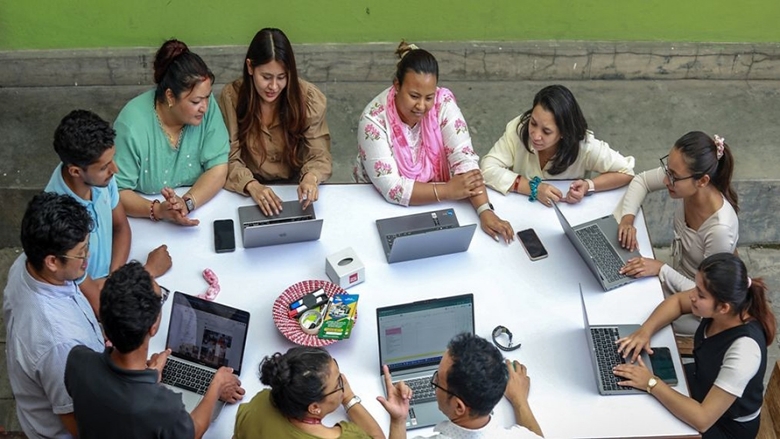The World Bank’s latest economic outlook explores growth prospects for South Asia and provides analysis on how the region can benefit from the green energy transition.
Main Messages
Charts & Data
South Asia growth forecasts
The forecast for growth in South Asia has been revised up in 2025, as recent GDP data from South Asian countries met or exceeded expectations. Growth is expected to slow from 6.6 percent in 2025 to 5.8 percent in 2026. Despite this deceleration, growth will remain stronger than in other EMDE regions.
Source: World Bank.
Note: Lines trace how South Asia’s growth forecasts for 2024–26 have changed across different issues of the South Asia Development Update between 2023 and 2025.
Growth in South Asian countries
Growth forecasts for 2026 have been downgraded for India, Maldives, and Nepal, driven by weaker export prospects, growing foreign exchange pressures, and social unrest, respectively. Forecasts for Bangladesh and Sri Lanka have been upgraded as crises recede and current account and fiscal balances narrow, strengthening growth prospect.
Source: World Bank.
Notes: BGD = Bangladesh; BTN = Bhutan; IND = India; LKA = Sri Lanka; MDV = Maldives; NPL = Nepal. With the exception of Maldives and Sri Lanka, all countries shown report on a fiscal-year basis. For those countries, “2025” and “2026” represent FY24/25 and FY25/26, respectively. For India, "2025" and "2026" refer to FY25/26 and FY26/27.
Artificial intelligence exposure and complementarity
Exposure to AI in South Asia is somewhat lower than in other EMDEs, but exposed jobs account for a disproportionately large share of earnings. Most of these jobs are complementary with AI, suggesting productivity gains; only 7 percent are at risk of displacement.
Sources: Felten, Raj, and Seamans (2023); Pizzinelli et al. (2023); World Bank, Global Labor Database.
Note: AI = artificial intelligence. Regional averages are weighted by working population (aged 16+). Exposure is defined as an occupational AI exposure score above the median. Complementary (substitutable) jobs have a complementarity score above (below) the median and above-median exposure. Bars show the share of jobs and total wage earnings that are exposed, complementary, or substitutable.
Workers in jobs protected by tariffs
In South Asia, about one-third of workers are employed in the least tariff-protected sectors, while in other EMDEs these sectors employ roughly twice as many workers.
Sources: Global Labor Database labor force survey microdata; World Trade Organization Analytical Database; World Bank.
Note: EMDEs = emerging market and developing economies; SAR = South Asia. Figure compares the employment distribution across sectoral averages of ad valorem most-favored-nation duties applied. Tariff data include para-tariffs for Sri Lanka. South Asia includes latest data for all six countries in the region; “other EMDEs” include six comparator countries: Brazil, Georgia, Mexico, Mongolia, Philippines, and Thailand.
Income gains from trade and labor reform
The real GDP per capita gains from lowering South Asia’s import barriers could be significantly greater when accompanied by reforms that improve worker mobility.
Sources: Asian Development Bank Multiregional Input-Output Tables (database). World Trade Organization Analytical Database; World Bank.
Notes: Figure shows real GDP per capita gains in South Asia from halving import barriers (relative to other EMDEs) and reducing job-transition costs by 5 percent. Estimates are based on a dynamic multi-sector open-economy model (Caliendo, Dvorkin, and Parro 2019), calibrated to 2023 data for 73 economies.
Revenue impact of past episodes of trade liberalization
On average, major tariff cuts in the past coincided with rising non-trade tax revenues that more than offset modest trade-tax revenue losses.
Sources: Haver Analytics; IMF Government Finance Statistics (database); UNU-WIDER; U.S. Agency for International Development Collecting Taxes (database); Vegh and Vuletin (2015); World Bank Fiscal Survey; World Development Indicators (database); World Bank.
Note: Episodes are the top decile of tariff reductions (first year and five-year horizon) across up to 122 countries (33 episodes in 31 countries). Tax revenue excludes social security contributions and grants. Blue bars show revenue-to-GDP differences over the first five years. Whiskers show 90 percent confidence intervals.
Blogs
Events
-
World Bank Oct 07, 2025
Previous Editions


























